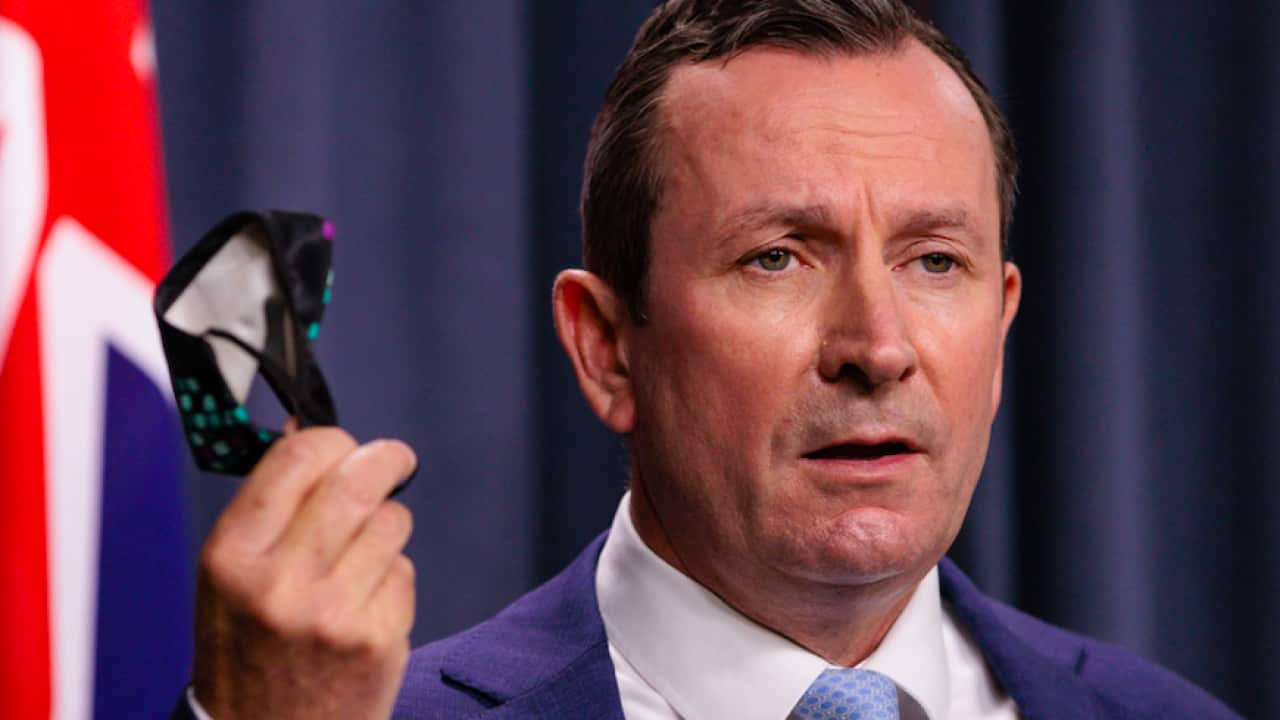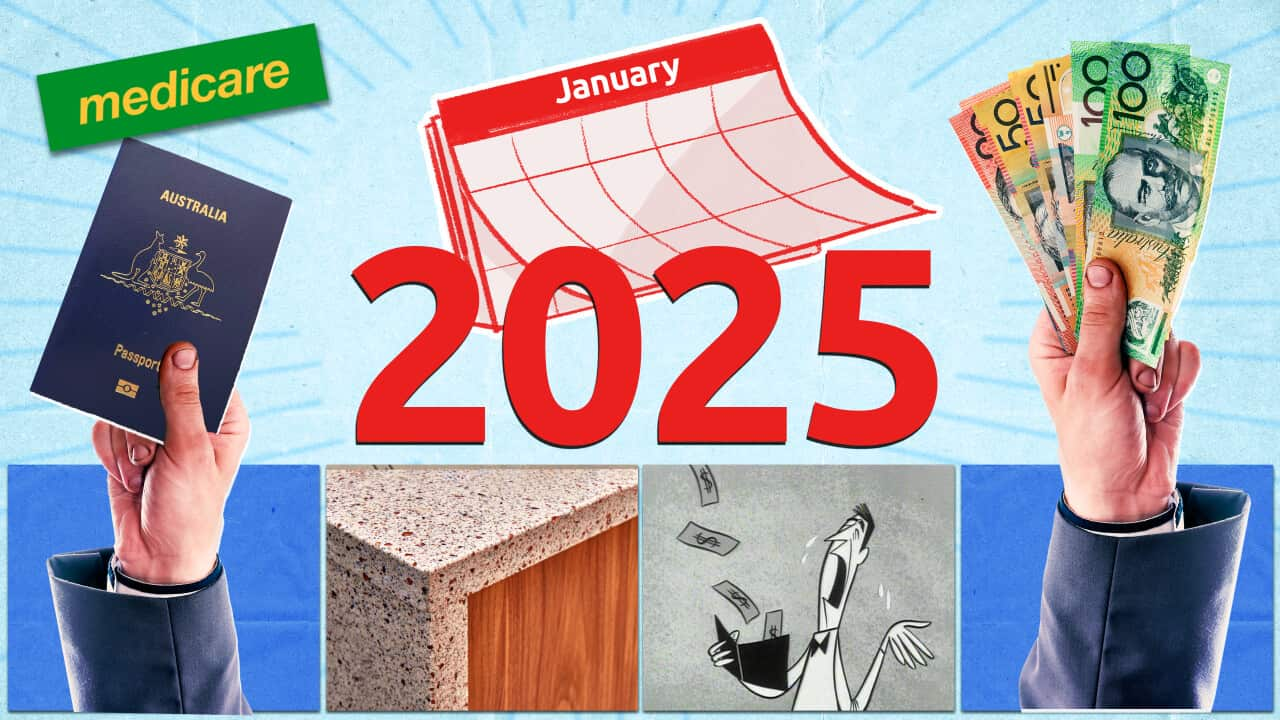Western Australian Premier Mark McGowan has warned social restrictions are likely to be introduced as the state reported 38 new local coronavirus cases.
Across Australia, another 46 COVID-related deaths were reported on Sunday. There were 18 deaths announced in Victoria, 22 in NSW, four in Queensland and two in South Australia, as hospitalisations continued to fall around the country.
In WA, where there is currently an indoor mask mandate and vaccination requirements to enter certain venues, the premier said on Sunday restrictions were all but inevitable.
"We haven't actually made a decision on when (further restrictions) will come in, but at some point in time they will come in," Mr McGowan said.
WA continues to add to its stockpile of rapid antigen tests but Mr McGowan says PCR testing will remain the preferred method so long as the state has capacity.
He says the state's clinics can handle 35,000 PCR tests daily and is currently only at about 15 to 20 per cent of that.
The state also has 8.8 million RATs in its stockpile, with another 2.4 million expected to arrive within the week.
It is mandatory to report positive RATs to state health authorities, which 10 of Sunday's positive cases had done.
"We just need to know what the spread of the virus is in the community and we rely upon people doing the right thing in order to inform us of that," Mr McGowan says.
Health Minister Amber-Jade Sanderson says a new advertising campaign will be launched to educate the public about close contact definitions and isolation requirements as the state prepares for "living with the virus".
"Our public health and social measures including mask wearing and isolation are doing a good job of keeping case numbers low but we do not expect that this will continue forever. We know that the Omicron variant is highly transmissible," Ms Sanderson said.
Victoria to lift its code brown alert
As Victoria is set to lift its code brown pandemic alert issued for the health system in January, the state recorded another 18 COVID-19 deaths and 7,223 new cases.
Of the new cases revealed on Sunday, 4,859 were detected through rapid antigen tests and 2,364 via PCR lab testing.
Health authorities say the state is now managing a touch under 55,000 active cases in total. There are 465 people in Victorian hospitals, 22 fewer than the day before.
Of these, 181 COVID-19 patients are in intensive care, 17 of them currently requiring ventilation.
With hospitalisations having halved since late January, the Victorian government has moved to lift its code brown pandemic alert.
The unprecedented alert was issued in January as hospitals and health services came under increasing pressure due to the Omicron wave that saw urgent services further cut back and staff leave postponed.
The measure has been in place for just more than three weeks and will be lifted at midday on Monday.
Meanwhile Premier Daniel Andrews said he's considering the future of QR code check-ins in his state with other jurisdictions having ended them, albeit with some exceptions.
"We hope to make some announcements quite soon," the premier told reporters on Sunday.
"Now that we've hit the peak of Omicron, now those cases are coming down, we do have some room to make some refinements and adjustments."
NSW hospitalisations continue to fall
NSW has reported a total of 6,686 new locally acquired cases of COVID-19 and 22 virus-related deaths.
Health authorities say 1,614 people are in hospital with the virus, 93 of whom are in intensive care, after the number of hospitalisations fell below 2,000 on Wednesday for the first time since January.
NSW Premier Dominic Perrottet said the state is in a "strong position" in the pandemic but was going through a "transition".
"If you take a step back and look at the hospitalisations and ICU presentations things are certainly heading in the right direction," Mr Perrottet told reporters on Sunday.
On Saturday the Australian Medical Association NSW joined a campaign from their federal counterpart calling on the Commonwealth to "pay their fair share for public hospitals".
The AMA is aiming to make hospital funding a major issue for the upcoming election, and wants an agreement struck for 50-50 funding between the federal and state governments.
The group said its campaign was aimed at highlighting chronic underfunding which it says has contributed to ambulance ramping, emergency waiting times and delays in elective surgery.
"Public hospitals were under pressure before the pandemic, but COVID really exposed the cracks in our system. Staff under-resourcing remains a difficult issue in NSW," AMA NSW president Danielle McMullen said.
Hospital data in Queensland taking 'a positive turn'
Queensland reported another four COVID-19-related deaths and 7,311 new cases on Sunday but its chief health officer is confident the state's Omicron wave is almost over.
The new cases emerged after 24,875 tests in 24 hours across Queensland including 2,066 RATs.
Of the four deaths, three were in aged care, none had a booster and one was vaccinated.
Three of the victims were aged in their 80s and the other in their 90s.
CHO John Gerrard was quietly confident the state's Omicron wave had almost passed due to the latest hospital numbers.
There are currently 462 COVID-19 patients in public hospitals (down from 508 on Saturday) with 44 in intensive care and 20 on ventilators.
In private hospitals there are 34 COVID-19 patients.
"The data I find most useful in tracking this pandemic is the hospitalisations data, and this is taking a really positive turn," Dr Gerrard said.
"Just 19 days ago we were at our peak of 928 patients. In 19 days we have halved the number of people in our hospitalisations.
"We are well on track to coming to the end of this wave of infection. Things are going far better than we had ever projected in terms of this Omicron wave."
Dr Gerrard believed the state was on track despite predicting a "significant rise" in children's cases following the return of school last week.
He said about 1,000-1,500 children had been diagnosed with COVID-19 every day across the state since school resumed but "almost all of them have a very mild disease".
"There is is still no clear trend in children but it is very early," Dr Gerrard said.
"It would be a very big surprise if we don't see a significant increase in the number of children in the next couple of weeks."
The latest figures show that 92.36 per cent of eligible Queenslanders have had one dose of a vaccine, while 90.31 per cent have had two.
In booster numbers, 61.15 per cent of eligible Queenslanders have had a third shot.
Two women die with COVID-19 in South Australia
In South Australia, two elderly women died with COVID-19 as the state reported 1,165 new cases on Sunday.
The women were both aged in their 80s.
There are 211 people with COVID receiving hospital treatment in the state, including 17 in intensive care and five require a ventilator.
South Australia has 13,621 active virus cases and 151 people have died with COVID since the start of the pandemic.
The number of PCR tests in SA dropped by 13 per cent to 7,944 on Saturday.
NT's COVID-19 vaccination rates growing among children
The Northern Territory government announced another 757 cases of COVID-19 on Sunday. There are 164 patients with the virus receiving hospital treatment, one of whom is in intensive care.
The territory has 7,332 active virus cases and there have been 10 deaths reported since the pandemic began.
The latest statistics were released as the government said 50 per cent of five-to-11-year-olds will have received their first COVID vaccine dose on Monday. Pediatric vaccines started in the Top End on 10 January, before the beginning of school in 2022.
Pediatric vaccines started in the Top End on 10 January, before the beginning of school in 2022.

Half of five-to-11-year-olds in the NT have now received their first COVID vaccine dose. Source: FR66830 AP
"Second doses will begin to rollout next month with children, aged five-11, recommended to receive another dose eight weeks apart," the government statement read.
"Almost 90 per cent of kids aged 12-15 have now received their first dose and 75 per cent have received two doses."
Tasmania reports lowest COVID count in weeks
Tasmania recorded 371 cases of COVID-19 on Sunday, the lowest number in more than a fortnight.
The figure took the island's total active case count to 3,189, with 10 patients in hospital including one in intensive care.
Tasmanians had been warned to expect a rise in infections, after some 60,000 public school kids started term one on Wednesday.
Twenty-three people have died with COVID in Tasmania since the start of the pandemic and 31,678 cases have "recovered".
The Australian Capital Territory, meanwhile, reported 458 new cases on Sunday. There are 50 people in hospital, down slightly from 51 on Saturday, four people in ICU and two on a ventilator.
With SBS News












